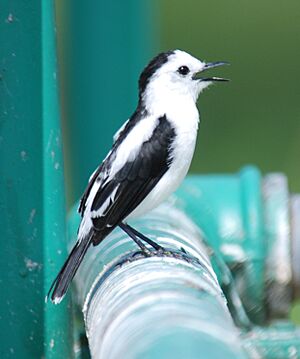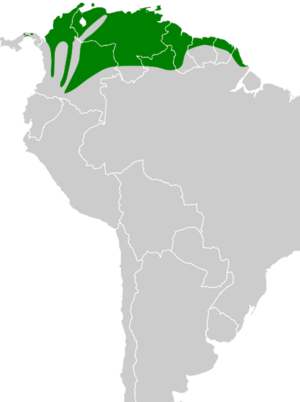Pied water tyrant facts for kids
Quick facts for kids Pied water tyrant |
|
|---|---|
 |
|
| Conservation status | |
| Scientific classification | |
| Genus: |
Fluvicola
|
| Species: |
pica
|
 |
|
The pied water tyrant (Fluvicola pica) is a small bird from the tyrant flycatcher family. It lives in warm parts of South America, from Panama and Trinidad all the way south to Bolivia.
Contents
About the Name
The scientific name for the pied water tyrant is Fluvicola pica. The name Fluvicola comes from Latin words. Fluvius means "river" and -cola means "dweller." So, Fluvicola means "river dweller," which makes sense because these birds live near water. The second part of the name, pica, is Latin for "magpie." This probably refers to the bird's black and white colors, like a magpie.
What They Look Like
The pied water tyrant is about 13.5 cm (5.3 inches) long. It weighs around 13 grams (0.46 ounces), which is about as much as a few paper clips.
Adult birds are mostly white. They have a black back, wings, and tail. Their neck (nape) is also black. Male and female birds look very similar. Sometimes, female birds might have a little brown mixed in with their black feathers. Young birds are brown where the adults are black.
When they call, it sounds like a nasal djweeooo.
Where They Live and What They Eat
Pied water tyrants like to live in wet, grassy areas called savannahs. They also live near the edges of mangrove swamps. You can often find them near water.
These birds mostly eat insects. They look for their food in the plants and bushes close to the water.
Reproduction and Life Cycle
The pied water tyrant builds a special nest. It's shaped like an oval ball and is made of grasses and other plant materials. Inside, the nest is lined with soft feathers. It has an opening on the side. They usually place their nest at the end of a tree branch, often hanging over water.
Both the male and female birds take turns sitting on the eggs. They usually lay two or three creamy-white eggs. These eggs have a few brown spots on them. Sometimes, other birds called cowbirds might lay their eggs in the pied water tyrant's nest, hoping the tyrants will raise their chicks.
Behavior
When a pied water tyrant is sitting on a branch, it often bobs its body up and down. They also have a special way of flying. It looks like a "butterfly" flight, where they flutter their wings a lot.


